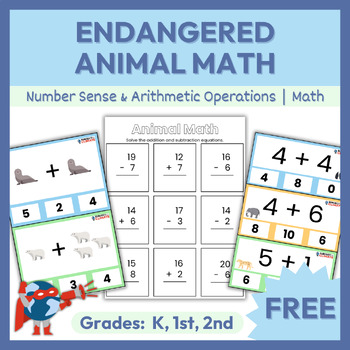Endangered Animal Number Sense Activities | K-2 | Free
SubjectToClimate
91 Followers
Grade Levels
K - 2nd
Subjects
Resource Type
Standards
CCSSK.CC.B.4
CCSSK.CC.B.5
CCSSK.OA.A.2
CCSS1.OA.C.6
CCSS2.OA.B.2
Formats Included
- Google Docs™
SubjectToClimate
91 Followers

Made for Google Drive™
This resource can be used by students on Google Drive or Google Classroom. To access this resource, you’ll need to allow TPT to add it to your Google Drive. See our FAQ and Privacy Policy for more information.
Description
Make math fun with this animal-themed clip card activity for K-2! Students will practice counting and operational skills using images of endangered and threatened animals. The clip cards can be used in a center or station, while the math worksheets can be completed independently or in groups.
★ ACCESS FREE RESOURCE HERE ★
★ WHAT’S INCLUDED ★
- Teacher Directions
- Materials List
- 6 Animal Counters
- 3 Counting Mats
- 18 Counting Clip Cards for Numbers 1-10
- 1 Counting Worksheet for Numbers 1-10
- 10 Counting Clip Cards for Numbers 11-20
- 1 Counting Worksheet for Numbers 11-20
- 24 Picture Addition & Subtraction Cards (within 5)
- 2 Picture Addition & Subtraction Cards (within 5) Worksheets
- 120 Picture Addition & Subtraction Cards (within 10)
- 1 Picture Addition & Subtraction Cards (within 10) Worksheet
- 53 Picture Addition & Subtraction Cards (within 20)
- 1 Picture Addition & Subtraction Cards (within 20) Worksheet
★ PRIMARY STANDARDS ★
Common Core Math Standards (CCSS.MATH)
- Counting & Cardinality (K)
- CCSS.MATH.CONTENT.K.CC.B.4 Understand the relationship between numbers and quantities; connect counting to cardinality.
- CCSS.MATH.CONTENT.K.CC.B.5 Count to answer "how many?" questions about as many as 20 things arranged in a line, a rectangular array, or a circle, or as many as 10 things in a scattered configuration; given a number from 1-20, count out that many objects.
- Operations & Algebraic Thinking (K-5)
- CCSS.MATH.CONTENT.K.OA.A.2 Solve addition and subtraction word problems, and add and subtract within 10, e.g., by using objects or drawings to represent the problem.
- CCSS.MATH.CONTENT.1.OA.C.6 Add and subtract within 20, demonstrating fluency for addition and subtraction within 10. Use strategies such as counting on; making ten (e.g., 8 + 6 = 8 + 2 + 4 = 10 + 4 = 14); decomposing a number leading to a ten (e.g., 13 - 4 = 13 - 3 - 1 = 10 - 1 = 9); using the relationship between addition and subtraction (e.g., knowing that 8 + 4 = 12, one knows 12 - 8 = 4); and creating equivalent but easier or known sums (e.g., adding 6 + 7 by creating the known equivalent 6 + 6 + 1 = 12 + 1 = 13).
- CCSS.MATH.CONTENT.2.OA.B.2 Fluently add and subtract within 20 using mental strategies. By end of Grade 2, know from memory all sums of two one-digit numbers.
Access this free resource here today so you can teach it tomorrow!
★ More Free Stuff! ★
Total Pages
Answer Key
N/A
Teaching Duration
N/A
Report this resource to TPT
Reported resources will be reviewed by our team. Report this resource to let us know if this resource violates TPT’s content guidelines.
Standards
to see state-specific standards (only available in the US).
CCSSK.CC.B.4
Understand the relationship between numbers and quantities; connect counting to cardinality.
CCSSK.CC.B.5
Count to answer “how many?” questions about as many as 20 things arranged in a line, a rectangular array, or a circle, or as many as 10 things in a scattered configuration; given a number from 1-20, count out that many objects.
CCSSK.OA.A.2
Solve addition and subtraction word problems, and add and subtract within 10, e.g., by using objects or drawings to represent the problem.
CCSS1.OA.C.6
Add and subtract within 20, demonstrating fluency for addition and subtraction within 10. Use strategies such as counting on; making ten (e.g., 8 + 6 = 8 + 2 + 4 = 10 + 4 = 14); decomposing a number leading to a ten (e.g., 13 - 4 = 13 - 3 - 1 = 10 - 1 = 9); using the relationship between addition and subtraction (e.g., knowing that 8 + 4 = 12, one knows 12 - 8 = 4); and creating equivalent but easier or known sums (e.g., adding 6 + 7 by creating the known equivalent 6 + 6 + 1 = 12 + 1 = 13).
CCSS2.OA.B.2
Fluently add and subtract within 20 using mental strategies. By end of Grade 2, know from memory all sums of two one-digit numbers.





